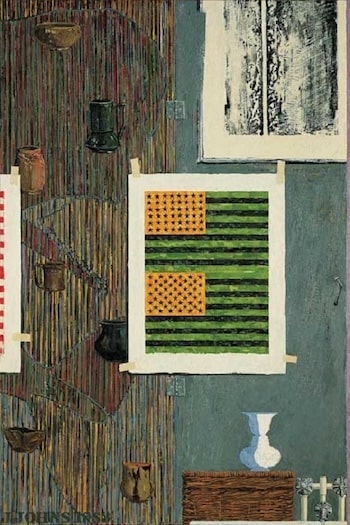Ventriloquist, 1983 by Jasper Johns

When Abstract Expressionism was at its height in the 1950s, Jasper Johns returned to concrete imagery. He painted simple icons: flags, numbers, and targets. In Ventriloquist, Johns
arranges such imagery to create a symbolic self-portrait. In the mid-1980s, for the first time in his painting career, Johns launched a series of paintings based on objects that he had collected
and images that he had created, pointing to his influences and artistic process. Ventriloquist is the most personal work of this series, one in which Johns drops his habitual reserve.
At first glance, the composition seems realistic, particularly the right half with its shaded nail, meticulously rendered wicker hamper, and detailed bathtub fixtures. However, the left half of
the composition plays more freely with illusionism. Images of the eccentric pots of visionary ceramicist George Ohr float unanchored. A whale, based on Barry Moser's 1979 illustrations of
Herman Melville's Moby-Dick, is embedded in the lines of the background. A stacked pair of American flags, one of the artist's most famous motifs, bridges the divide. However, rather than
rendering them in the familiar red, white, and blue, Johns paints the central flags in their negative opposite tones. Similarly, the black-and-white image in the upper right corner is a careful,
but reversed, copy of a Barnett Newman lithograph Johns admires. In Ventriloquist, Johns "speaks" through these works of art and pictorial inversions. Like a ventriloquist projecting his
voice through a dummy, he mobilizes an array of objects and images to address his place among the rich abundance of America's visual culture.
